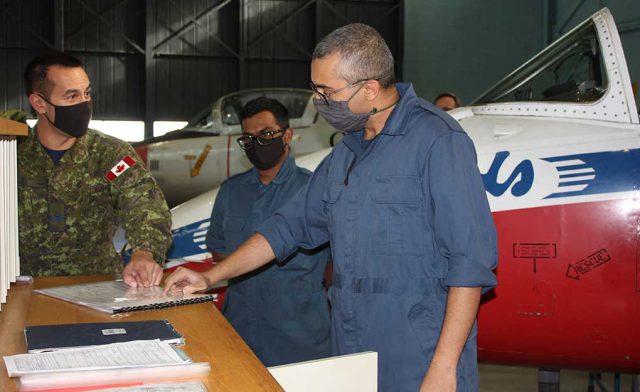Trust, accountability, and critical thinking.
These are the cornerstones of the members at the Canadian Forces School of Aerospace Technology and Engineering (CFSATE).
The role of CFSATE is to provide the Air Force with qualified personnel to ensure Aircraft serviceability by developing and carrying out individual aerospace engineering training in accordance with approved doctrine and standards.
CFSATE trains in a number of Trades, including Aviation Systems Technician, Avionics Systems Technician, Aircraft Structures Technician, Air Weapons Systems Technician and Aerospace Engineering Officer. Open to both Regular and Reserve Force, technicians for certain trades are welcome even with no post-secondary education or trades background.
Accountability plays an important role in the mindset of successful candidates. Regardless of rank, technicians are the ones with their hands on an aircraft, certifying its airworthiness and ensuring full mission capability. According to Lieutenant-Colonel Sylvestre Bishop, CFSATE Commandant, it’s lends a different mindset than other branches of the Canadian Armed Forces.
“We want critical thinkers,” said LCol Bishop. “We want folks that can work in a professional environment where they challenge each other to ensure all aspects and requirements adhere to the required standards.”
Unique training is offered through a combination of classroom and practical hands-on learning in a phased approach, with training methods that vary to best suit the requirements of a given role. Those on supervisory track such as Aerospace Engineers (AERE) and Air Maintenance superintendents (AM Sup) focus on developing soft skills such as maintenance and fleet management, airworthiness principles, and counselling in mock office settings and exercises, while technicians focus on hands-on apprenticeship learning. This approach ensures that individuals are learning the fundamentals of the job from the moment they step through the doors.
Technicians start with the fundamentals maintenance training by giving them the basic knowledge they will later be able to transfer to their assigned fleet and begin on-the-job training with the aircraft they’ll be working on, often long term. It’s not unusual for technicians to spend anywhere from seven to 14 years on the same fleet.
“It’s not about saturating them with information, it’s about starting simple so students can work their way up,” said MWO Brian Berube, CFSATE Acting/School CWO.
It takes roughly 3.5 to 4 years for a technician to become fully trained and able to be accountable for knowing an aircraft is safe to take flight.
“We’re very early on instilling into these technicians that we’re training [at CFSATE] that their decisions and actions will matter,” said LCol Bishop.
With so much on the line, and constant advancements in technology, continuous learning is key to success – and safety.
“In my 35 year career, I’ve been on so many courses on different fleets and my training has always continued. And it always has to. You always have to stay current,” said MWO Berube.
Roughly 40 per cent of the Royal Canadian Air Force passes through CFSATE for training.















